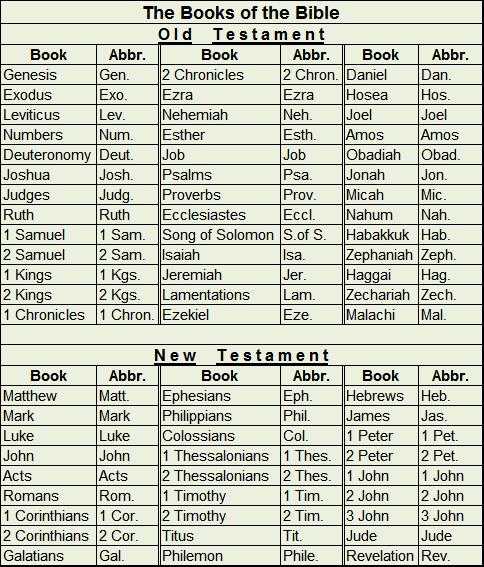
Lesson 1
AN INTRODUCTION TO THE BIBLE
(New King James Version (NKJ)
This is the first lesson of a 16 lesson online
Bible study series. These studies provide Bible answers to Bible
questions and will guide you to God's truth as revealed by His
Holy Word. These lessons are only available at this Internet
site.
The purpose of this lesson is to introduce you to the Bible. The lesson will tell you where the Bible came from, why it was written, how it is organized, and how to find references to specific parts of it.
1. Origin of the Bible
The Bible is one of the world's oldest books. Its oldest sections were written about 1500 years before the birth of Christ. Even its newest sections were written about 1900 years ago.Clearly, then, having been written over a period of about 1600 years, the Bible was not written by one person. No one knows precisely how many people contributed to the Bible. It is estimated there were about forty authors.
One of the most important facts about the Bible is that those who wrote it did not claim to be the source of the ideas they wrote about. Sometimes directly, sometimes indirectly, the authors assert that what they were writing really came from God. For example, one of the writers, Paul, made this statement: All Scripture [i.e., the Bible] is given by inspiration of God, and is profitable for doctrine, for reproof, for correction, for instruction in righteousness, that the man of God may be complete, thoroughly equipped for every good work (2 Tim. 3:16-17). Another writer, Peter, wrote: for prophecy never came by the will of man, but holy men of God spoke as they were moved by the Holy Spirit (2 Pet. 1:21). Other Bible writers confirm the statements of Paul and Peter.
Through the years there were those to whom the writings of men such as Paul and Peter were sacred. They understood these writings originated with God Himself. Some of these people dedicated themselves to collecting, arranging, and preserving the Scriptures that existed in their day. Today the names of most of those who did this work are unknown to us. We do know that well before the time of Christ the Jews had already finished assembling the divinely inspired writings of the Hebrews. It is a collection of 39 books. In the list of Bible books appearing elsewhere in this lesson, it is called the Old Testament. Following Christ's life on earth, additional sacred books were written. Some of these books record historical events pertaining to Christ and His early followers. Others are letters written to explain Christ's teaching or to encourage the followers of Christ to practice the moral principles He taught. There are 27 books in this later collection. Together they form the New Testament.
Bible References
The Bible is divided into books, the books into chapters. and the chapters into verses. Several similar formats can be used to refer to specific chapters or to specific verses. The examples below illustrate the possibilities.References to Chapters
Gen. 1 Refers to chapter 1 in the book of Genesis.
Exo. 12-20 Refers to chapters 12 through 20 in the book of Exodus.
References to Verses
Gen. 1:1 Refers to verse 1 of chapter 1 in the book of GenesisExo. 12:22a Refers to the first part of verse 22 of chapter 12 in the book of Exodus.
Exo.12:22b Refers to the second part of verse 22 of chapter 12 in the book of Exodus.
Lev. 25:8-17 Refers to verses 8 through 17 of chapter 25 in the book of Leviticus.
Num. 7:6,9 Refers to verse 6 and to verse 9 of chapter 7 in the book of Numbers.
2. Purpose of the Bible
Perhaps at some time you have said, "Nobody's perfect." You said
it because you made a mistake others were aware of. You felt you
needed to justify yourself but had no other explanation to
offer. The Bible makes similar statements about every human
being:
The LORD has looked down from heaven upon the sons of men to see if there are any who understand, who seek after God. They have all turned aside, they have together become corrupt; there is none who does good, no, not one (Psa. 14:2-3).
Anything you do, or fail to do, that displeases God is called "sin." Whenever you sin, you drive a wedge between yourself and God: Behold, the LORD's hand is not shortened, that it cannot save; nor His ear heavy, that it cannot hear. But your iniquities have separated you from your God, and your sins have hidden His face from you, so that He will not hear (Isa. 59:1-2). Unless something is done to erase your sins, you will remain separated from God forever. Paul compared committing sin to working at a job. He pointed out that the wages of sin is death (Rom. 6:23a). He was not referring to mere physical death but to spiritual death. Elsewhere he describes spiritual death as eternal destruction from the presence of the Lord and from the glory of His power (2 Thes. 1:9b).
The Bible is very much concerned with sin--not just with your sin but with everyone's sin. The Bible reveals God's great plan for bringing about the forgiveness of our sins. When we follow the plan, God forgives our sins and will reward us with everlasting life: the gift of God is eternal life in Christ Jesus our Lord (Rom. 6:23b). The Bible is about changing from death to life, from destruction to salvation.
3. The Unity of the Bible
The theme of salvation from sin, which runs throughout the pages
of Scripture, is one of the attributes of the Bible showing its
harmony and consistency. It is remarkable that such unity could
be maintained by so many writers, who lived at different times,
at different places, and in different cultures. They did not all
speak the same language and did not all write in the same
literary form. It is as if the books of the Bible are the
instruments in an orchestra whose diverse sounds blend
harmoniously under the direction of the conductor. When we
recognize that the writers themselves were not the original
sources of the information and ideas they expressed but were
acting under the direction of God, we can understand why the
Bible forms a unit.
4. The Content of the Bible
"How To ..." books and articles are popular today. It is not
hard to find information on how to train a dog, how to wire a
house, how to lose weight, how to quit worrying, how to increase
one's vocabulary, or how to improve one's marriage. When we read
these publications, we expect them to give us a point-by-point
plan for achieving a goal. If you expect to find that kind of
recipe for salvation in the Bible, you will be disappointed. God
has not chosen to unfold his plan for removing sin as a simple
list of "Do's" and "Don't's".

Instead, God has chosen to unfold His plan by having us
consider His dealings with certain groups of people over a long
period of history. As we read the Bible we see how God
interacted with these people. We learn more and more about the
nature of God and about the kind of response He desires from us.
From the Bible we learn how the human race began and how sin
first entered the world and continued to be practiced. We learn
about God's response to those who were wicked and to those who
were righteous. Sometimes God's response involved miracles. More
often than not, God's response was communicated through men He
chose as His special agents. The record of what they said and
wrote spans a variety of literary styles. Some parts of the
Bible are simply the records of historical events. Other parts
are prayers or thanks to God stated in poetic form. Still other
parts are sermons that were preached, predictions that were
made, or personal letters that were written.
As we read through the Bible, we begin to realize that we, like the men and women of the Bible, are guilty of displeasing God. We see that we are powerless to reverse the process by which we isolated ourselves from Him. We also begin to realize that God loves us, disobedient though we are, and that He has devised a way for us to be forgiven and saved.
The central feature of God's plan is Jesus Christ. Jesus left heaven to come to earth to live as one of us. He experienced the temptations, disappointments, and heartaches that we experience. Then He died for us as a perfect sacrifice for sin. For God so loved the world, that He gave His only begotten Son, that whoever believes in Him should not perish, but have everlasting life (John 3:16).
The aim of the lessons in this series is to help you read,
study, and understand the Bible. If you decide to study all the
lessons in this series, you will have made a choice that may
have far-reaching consequences for you personally. The Bible can
become a mirror that enables you to see yourself as God sees you
and a messenger that tells you how to become what God wants you
to be.
If you have difficulties in exercising this lesson procedure, please send an E-mail message describing the difficulty to:
webmaster@jordanpark.org
Be sure to specify the following:
1. Lesson number,
2. Bible version,
3. Your browser name and version,
4. Your operating system.
5. Any error message(s)
Visit the Jordan Park Homepage
© 2020, 1998 JORDAN PARK CHURCH OF CHRIST
HUNTSVILLE, ALABAMA
PRIVACY POLICY